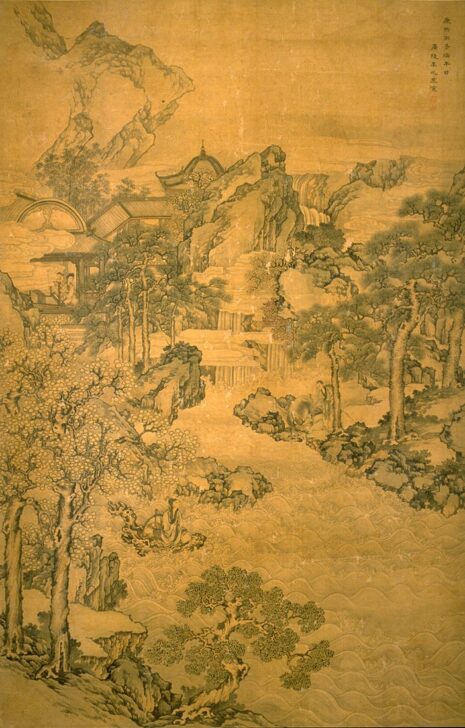A Han Dynasty Envoy Navigating on a Tree-Raft
Yu Zhiding (Yü Chih-ting); Yu Zhiding (Yü Chih-ting)

Description
Inscription: On the Dragon Boat Festival Day in the year 1696 of the Kangxi era. Yu Zhiding
Two seals of the artist
This work by the accomplished artist Yu Zhiding refers to the legend of Zhang Qian (active 139–87 BCE), who was commissioned by the emperor to find the source of the Yellow River. According to legend, he navigated up the river on a raft and finally reached the Milky Way where he met two celestial beings, the Herd Boy with his buffalo (the figures at right) and the Weaver Maiden (the woman in the pavilion). These are the names given to two stars that appear together in the sky on only one night of the year, on the seventh day of the seventh lunar month. A change was observed in their configuration by the court astronomer, who took this as a sign of confirmation that Zhang Qian had found the source of the Yellow River.
Gallery Rotation Winter 2012
Yu Zhiding
China, 1647–ca. 1705
A Han Dynasty Envoy Navigating on a Tree-Raft
Qing dynasty (1644–1912)
1696
Hanging scroll, ink and light color on silk
Museum purchase made possible by the Margaret Watson Parker Art Collection Fund, 1985/2.30
This painting refers to the legend of Zhang Qian (active 139–87 bce), who was ordered by the emperor to find the source of the Yellow River, the second longest in China. In the story Zhang Qian navigated up the river on a raft, eventually reaching the Milky Way. There he met two celestial beings, the Herd Boy with his buffalo (the figures at right) and the Weaver Maiden (the woman in the pavilion), whose stars appear together in the sky on only one night of the year—the seventh day of the seventh lunar month. When a court astronomer of the time observed a change in the configuration of these stars, it was taken as a sign that Zhang Qian had accomplished his mission.
Yu Zhiding came from a humble background with no documented formal training in painting. He rose quickly, however, to become a portrait painter of elite scholars and high officials. His mastery of portraiture may be seen here in the clearly defined features of the human faces and the exquisite brushwork of the buildings, figures, trees, and rocks.
Subject Matter:
This painting refers to the legend of Zhang Qian (active 139–87 BCE), who was ordered by the emperor to find the source of the Yellow River, the second longest in China. Zhang Qian navigated up the river on a raft, eventually reaching the Milky Way. There he met two celestial beings, the Herd Boy/cowherd with his buffalo (the figures at right) and the Weaver Maiden (the woman in the pavilion), whose stars appear together in the sky on only one night of the year—the seventh day of the seventh lunar month. When a court astronomer of the time observed a change in the configuration of these stars, it was taken as a sign that Zhang Qian had accomplished his mission.
Yu Zhiding came from a humble background with no documented formal training in painting. He rose quickly, however, to become a portrait painter of elite scholars and high officials. His mastery of portraiture may be seen here in the clearly defined features of the human faces and the exquisite brushwork of the buildings, figures, trees, and rocks.
Physical Description:
This is a dense but muted landscape painting. The lines are very well defined. The colors consit of muted greens and browns, with a bid of red in some places. There is a river flowing through the center of the painting, running down the landscape and toward the viewer. There is a figure sitting on a gnarled tree-raft towards the bottom left of the painting, with another figure looking upon the scene from the opposite bank of the river. There are ornate buildings present toward the top of the panting. The viewer can see a lone figure in an interior covered by stylized clouds.
Usage Rights:
If you are interested in using an image for a publication, please visit https://umma.umich.edu/request-image/ for more information and to fill out the online Image Rights and Reproductions Request Form.